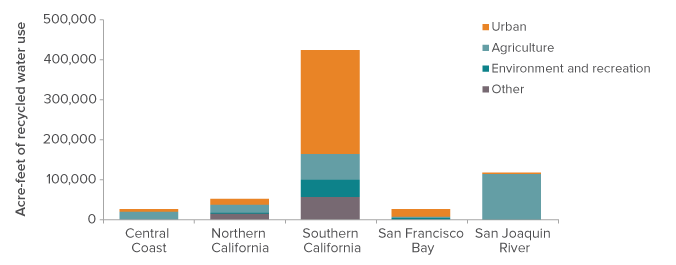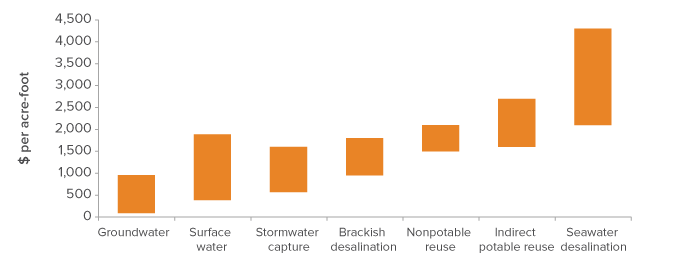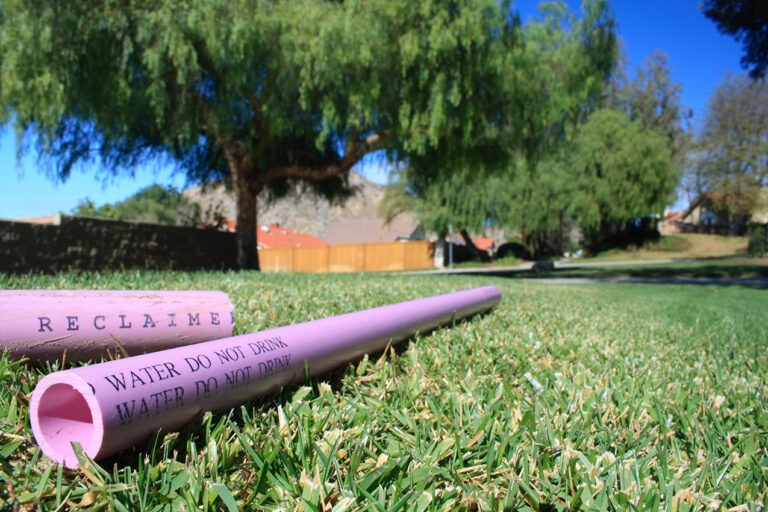- Alternative supplies are a small but important part of the state’s water portfolio.
Alternative water sources―recycled wastewater, urban stormwater, and desalinated seawater and brackish water―now provide 2‒3% of the state’s urban and farm water supply, and they are growing rapidly. Recycled water use has more than doubled since the late 1980s to 700,000 acre-feet annually. Desalination capacity grew more than fourfold since 2006 to nearly 200,000 acre-feet in 2016. Much of this growth is due to investments by urban water agencies, particularly in Southern California. This trend is expected to continue.
Southern California communities have invested heavily in recycled water

SOURCE: State Water Resources Control Board. Municipal Wastewater Recycling Survey, 2017.
NOTES: The figure shows municipal recycled water use in 2015. Southern California includes the South Coast, Colorado River, and South Lahontan hydrologic regions. Northern California includes the North Coast, Sacramento River, and North Lahontan hydrologic regions. Urban includes groundwater recharge, landscape irrigation, commercial use, and golf courses. Other includes water used for geothermal production, preventing seawater intrusion, and other uses.
- Having a mix of water sources improves drought resilience.
Water managers traditionally rely on a mix of surface water and groundwater to meet water supply needs. But increasingly they’re looking to alternative sources to augment supplies and buffer against drought. On-site water reuse—whether in buildings, homes, or on farms—can also reduce demand for existing supplies. Previous droughts have prompted many water managers to supplement their supply portfolios with one or more of these alternative supplies. Many utilities plan to build alternative supply projects over the next decade. - Some alternative water sources are particularly drought resistant.
Since recycled and desalinated water are not directly linked to weather conditions, they increase reliability when traditional supplies are constrained by drought. However, a number of factors can affect the reliability or limit the use of alternative sources. For example, the amount of municipal wastewater for recycling can be limited by indoor water conservation. Stormwater captured by retention basins, permeable pavement, or roof-top collection requires adequate rain and accessible above- or below-ground storage. Geography is also a constraint. Desalination of seawater is extremely reliable but is limited to coastal communities. Brackish water desalination is also very reliable but requires a source of saline groundwater or surface water. - In general, alternative water supplies are more expensive.
While developing alternative supplies may be cheaper in some cases than investing in new surface or groundwater sources, they are often more expensive per unit of water produced than traditional supplies. Along with the initial cost of construction, recycling and desalination processes can have significant ongoing energy costs. Yet utilities may be willing to pay a premium for new alternative sources that boost reliability. Even seawater desalination—one of the most costly sources—is a viable option in some coastal communities where other supplies are not adequate to meet demands during droughts. Demand management approaches, such as water use efficiency and water trading, can make water available more cheaply than investments in new supplies. Decisions to invest in alternative supplies are complex and based on local circumstances. What works in coastal cities might not work in inland areas, and what works in Southern California might not work in Northern California.
Alternative supplies generally cost more than new surface and groundwater sources

SOURCES: Groundwater costs: Perrone, D. and M. Rohde, “Benefits and Economic Costs of Managed Aquifer Recharge in California,” 2016. Surface water costs: calculated by the authors using data from the Water Storage Investment Program of the California Water Commission. All other costs: Cooley, H. and R. Phurisamban, “The Cost of Alternative Water Supply and Efficiency Options in California,” Pacific Institute, 2016.
NOTES: All cost estimates include annualized capital and operations and maintenance costs. Nonpotable reuse involves the use of treated municipal wastewater for irrigating landscapes or agriculture, restoring habitat, or incorporating into industrial processes. Indirect potable reuse is the storage of treated municipal wastewater in groundwater or surface storage before it is distributed as drinking water. New surface water costs were calculated based on the cost and estimated yield of five proposed storage projects. Chart shows 2015 dollars.
- Alternative water supplies face regulatory hurdles.
The state is developing regulations to enable the expansion of alternative sources while addressing public health and environmental risks. Storing recycled water in groundwater basins is already authorized, and it will soon be possible to store recycled water in surface reservoirs. The state is also working on regulations for integrating recycled water directly into drinking water systems—a method that will require additional safeguards to protect public health. Regulation of on-site wastewater or stormwater reuse is challenging, as public health managers must oversee many individual and decentralized sites. The evolving statewide policy framework for on-site reuse is being informed by lessons from pioneering local efforts, such as the San Francisco Public Utilities Commission’s nonpotable water program. The state’s new policy for seawater desalination plants is designed to minimize harm to marine life.
Topics
Drought Paying for Water Water Supply Water, Land & Air

